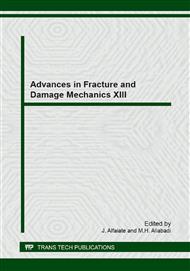p.445
p.449
p.453
p.457
p.461
p.465
p.469
p.473
p.477
Influence of Different Crack Propagation Rate Descriptions on the Residual Fatigue Lifetime of Railway Axles
Abstract:
The paper deals with an estimation of the residual fatigue lifetime of the railway axles. The railway axles can include some cracks either from manufacturing process or from previous loading operation. Because of cyclic loading of the railway axles there is a risk of fatigue failure of the railway axles with unacceptable consequences. Based on this fact, for conservative establishment of the residual fatigue lifetime of the railway axle is necessary to consider an existing crack in the railway axle during design process. The fatigue lifetime estimation of railway axles is very sensitive to used crack propagation rate description (e.g. v-K curve). Typical bending of this curve (knee) can be found in the vicinity of the threshold value in fatigue crack propagation rate dependence (typically v-K curve expressed in log-log coordinates). For accurate estimation of residual fatigue lifetime of the railway axle is necessary to use approximation of v-K curve that takes into account existence of the knee close to the threshold value of the stress intensity factor. The paper shows important differences between different crack propagation rate descriptions on the residual fatigue lifetime estimation of the railway axles. Results obtained can be used for safer design and operation of the railway axles.
Info:
Periodical:
Pages:
469-472
Citation:
Online since:
September 2014
Authors:
Price:
Сopyright:
© 2015 Trans Tech Publications Ltd. All Rights Reserved
Share:
Citation:


